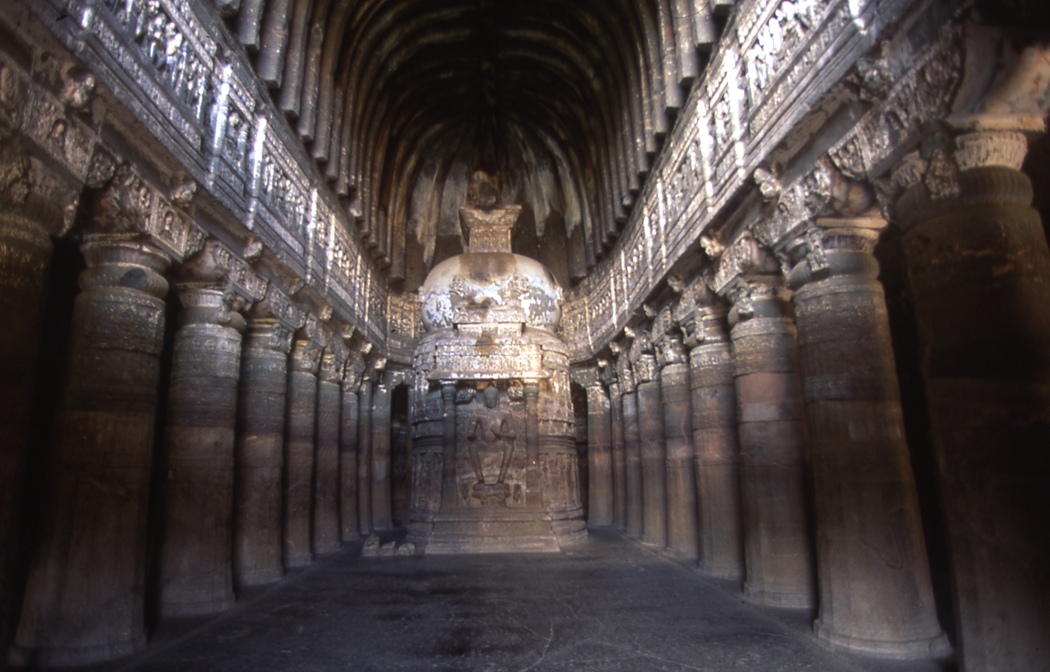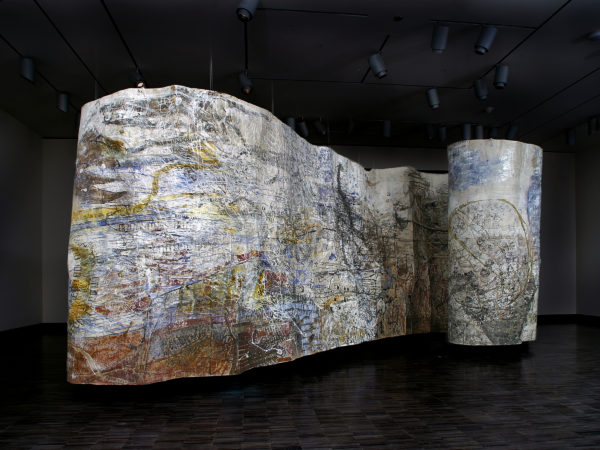Activity
Buddhist Caves at Ajanta
Learn about Buddhist caves. This is one of a series of caves excavated out of the volcanic rock that extends along a cliff overlooking the Wagora River at Ajanta, about two hours north of the present-day city of Aurangabad, in Maharastra state in western India.

Interior of Cave 26, Ajanta, India. Photo by Olivier Laude, 1999.
What is this building?
This is one of a series of caves excavated out of the volcanic rock that extends along a cliff overlooking the Wagora River at Ajanta, about two hours north of the present-day city of Aurangabad, in Maharastra state in western India. The Ajanta caves predate the caves equally famous at Ellora, but they are entirely Buddhist. There are early caves at Ajanta, from about the same time as the stupa at Sanchi (approx. 200–100 BCE), and later caves, dating from around 450 to 500 CE. This cave is numbered 26, and dates from the later period—around the 470s.
Why did Buddhists use caves?
Early Buddhists worshiped at stupas containing relics of the Buddha, as well as at other sites associated with his earthly existence. Buddhist monastics gained the support of some of India’s ancient rulers. These rulers offered tracks of land and financial support to Buddhist monks as a way to gain the loyalty of their subjects. Buddhism also appealed to merchants and laypersons. Buddhist monasteries began to appear along trade routes, usually within one day’s journey from each other. Merchants and travelers could rest or stay at the monasteries, in return for a financial offering. Caves offered practical shelter during the rainy (monsoon) season in India. They were cool during the dry, hot season, and they were durable.
What are the artistic developments represented by the cave?
The Buddhist and Hindu rock caves scattered throughout western India help us to chart artistic developments in ancient India, since most other buildings from that time were made of materials that have not survived. The caves at Ajanta also contain the earliest surviving group of paintings from ancient India (other than prehistoric evidence). We know from incomplete caves at Ajanta that masons and sculptors worked from top to bottom to excavate the caves and create architectural and sculptural forms.
There are two main types of cave structures at Ajanta. One is the square-shaped cave that contained cells where the monks resided. Over time, these became more elaborate and incorporated secondary shrines. The other main structure was the worship hall or shrine, called a chaitya. The early chaityahalls at Ajanta are carved into the rock in a bullet shape with a rounded end called an apse. The vaulted ribs at the top were carved to simulate wooden beams. At the centre of the apse was the stupa shape. The hall itself is lined with pillars, and behind the pillars and apse is an ambulatory passage, allowing the worshiper to walk around the stupas as a form of worship.
We know the chaitya represented here (cave 26) is a later development, because the rock-cut image of the seated Buddha appears, as if emerging out of the stupa (in the lower center part of the photograph). In contrast to the earlier caves, this cave is also much more elaborately decorated. This is important, because we know that Mahayana Buddhism was becoming more popular at this time, and with it, multiple images of the Buddha in human form, as well as images of supporting figures known as bodhisattvas, appear abundantly in Buddhist art. The Ajanta caves provide direct evidence of early Buddhist art, patronage, and architectural forms that would influence the spread of Buddhism and Buddhist imagery across Asia.
Historical Footnote:
At the time this cave and others at Ajanta were excavated, India was ruled by the Gupta dynasty and in the western Deccan region by the Vakatakas, whose king Harishena (reigned 460–478 CE) was a follower of the Brahmanic (Hindu) traditions. Some of Harishena’s ministers, however were followers of Buddhism and it was principally these individuals who commissioned the later caves at Ajanta. Cave 26 in fact contains an inscription stating that the donor was a powerful monk by the name of Buddhabhadra, and it was dedicated to a former minister of a rival group who were about to overrun the Vakataka dynasty. Commissioning this cave, therefore, may have been both an act of merit as well as a political maneuver among ministers jostling for power. Part of the inscription reads, “A man continues to enjoy himself in paradise as long as his memory is green in this world. Why should one therefore not set up a memorial in the mountains that will endure as long as the moon and sun shine in the skies?”





